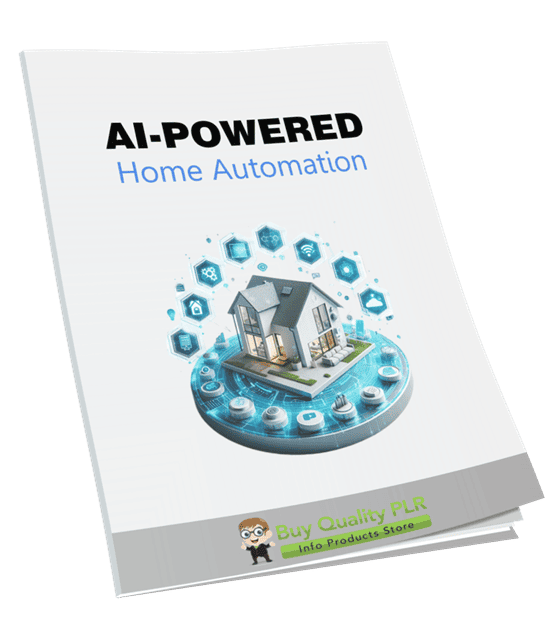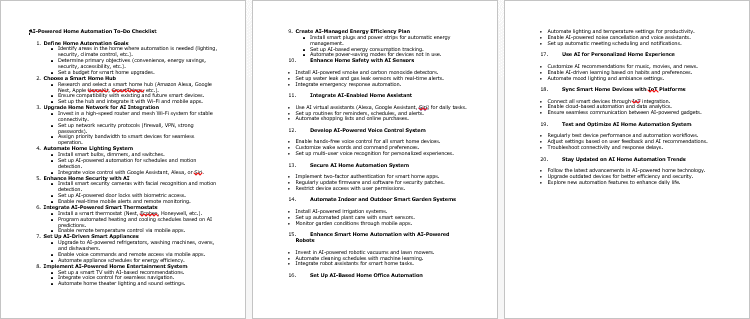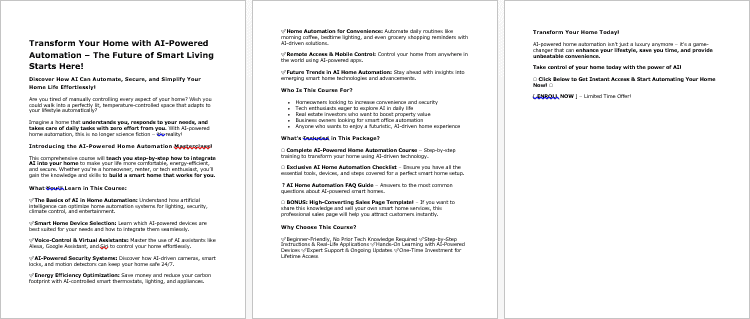
Ai-Powered Home Automation PLR Course 34k Words
in Artificial intelligence PLR , Artificial Intelligence PLR eBooks , Home Improvement PLR , Home Improvement PLR Ebooks , PLR Checklists , PLR eBooks , PLR eCourses , PLR List Building Reports , PLR List Building Reports , Premium PLR , Premium PLR eBooks , Premium PLR Reports , Premium White Label Brandable PLR Coaching Courses , Private Label Rights ProductsChoose Your Desired Option(s)
has been added to your cart!
have been added to your cart!
#smarthome #homeautomation #aiautomation #smartliving #plrcourse #techsavvyliving #plrcontent #diyhometech
Transform Your Home into a Smart, AI-Driven Space
Are you ready to take your living space into the future? With AI-powered home automation, you can create a truly intelligent home that adapts to your needs, enhances your lifestyle, and provides greater convenience. Whether you’re a beginner or looking to elevate your existing smart home setup, this comprehensive PLR course is your perfect guide to mastering AI technology for home automation.
By the end of this course, you will be equipped with everything you need to transform your home with cutting-edge AI tools, ensuring that your living space is not only smart but also energy-efficient, secure, and fully automated.
Presenting…
Ai-Powered Home Automation PLR Course 34k Words
What’s Included in the AI-Powered Home Automation PLR Course?
This 32,170-word PLR course is packed with valuable information to help you navigate and implement AI-powered smart home systems. Here’s a breakdown of what’s inside:
Module 1: Understanding AI & Home Automation Basics
Start with the foundation of AI-powered home automation. Learn what AI is, how it enhances traditional automation, and the essential components that make up a smart home.
- What is AI-Powered Home Automation?
Discover the basics of AI and how it works within smart home systems. - Core Components of a Smart Home
Explore smart speakers, hubs, sensors, IoT devices, and more. - Benefits & Real-World Applications
Understand the many benefits of AI-powered homes, including improved energy efficiency and security. - Choosing the Right AI Home System
Compare popular platforms like Amazon Alexa, Google Home, and Apple HomeKit to select the best one for you.
Module 2: Setting Up Your AI Smart Home System
Now that you understand the basics, it’s time to set up your own smart home. This module provides step-by-step instructions for selecting devices and connecting them to create a seamless AI-powered system.
- Selecting Your Smart Hub & Devices
Choose between different hubs and devices, from thermostats to smart lights and security cameras. - Connecting & Configuring Devices
Learn how to integrate your devices using mobile apps and platforms. - Automating Daily Routines with AI
Create smart routines like controlling your lights, thermostat, and appliances automatically. - Troubleshooting Setup Issues
Resolve connectivity problems with easy solutions and tips for getting everything running smoothly.
Module 3: Advanced AI Automation & Customization
Take your automation to the next level! This module teaches you how to fully customize your system and make the most out of voice assistants, routines, and security features.
- Using AI Voice Assistants for Hands-Free Control
Master voice commands with Alexa, Google Assistant, or Siri to control your home. - Creating Smart Home Routines & Scenes
Set up personalized routines that automate multiple actions with a single command. - Integrating AI with Home Security
Learn how AI-powered security systems can protect your home and alert you to unusual activity. - Energy Efficiency & AI Optimization
Optimize energy usage with AI, from controlling heating and lighting to managing water usage.
Module 4: AI and IoT – Expanding Your Smart Home
Explore the synergy between AI and the Internet of Things (IoT) to create a fully connected home. Learn how to connect third-party devices and let AI adapt to your habits and preferences.
- Understanding IoT & Its Role in Smart Homes
Learn how IoT devices work together with AI systems to create a smart home. - Connecting Third-Party Smart Devices
Integrate devices that aren’t directly compatible with your AI home system through third-party platforms like IFTTT. - Smart Home AI Learning & Predictive Automation
Discover how AI can learn your preferences and suggest automation to improve your home’s efficiency. - AI-Powered Home Entertainment & Smart Assistants
Automate entertainment systems with AI, from playing music to controlling your TV and gaming consoles.
Module 5: Future Trends & Scaling Your Smart Home
The smart home revolution is evolving rapidly. In this module, you’ll learn about the latest trends in home automation and how to future-proof your smart home setup.
- Emerging AI Technologies in Home Automation
Get ahead of the curve with the latest smart home innovations like robotic assistants and AI-powered sustainability. - Expanding Your Smart Home with New Devices
Stay up-to-date with new devices that will enhance your AI-powered home. - AI & Home Data Security
Understand the privacy concerns of AI-powered homes and how to secure your smart home data. - Building a Fully Integrated AI-Powered Smart Home
Plan and scale your home automation system for maximum efficiency and future-proofing.
Bonuses Included with Your PLR Course Package
- AI-Powered Home Automation Checklist
A 670-word checklist to ensure you’re not missing any critical steps in setting up your AI smart home system. - AI-Powered Home Automation FAQ
A 876-word FAQ section to answer the most common questions about AI smart homes. - Sales Page for AI-Powered Home Automation
A 538-word sales page that you can use to promote and sell this course on your website or online store.
How You Can Profit from This Course
The AI-Powered Home Automation PLR Course is a comprehensive, ready-to-sell PLR package that can be used in various ways to generate income:
- Sell the course as-is: You can sell this course directly on your website as a valuable digital product.
- Bundle with other tech-related content: Create a larger product bundle with other smart home or AI-related products and sell it for a higher price.
- Create a membership site: Offer exclusive access to the course content on a subscription basis for ongoing revenue.
- Turn the course into a video series: Convert the content into a video format, offering it as a premium video course.
- Use as a lead magnet: Offer this course as a freebie in exchange for email sign-ups, and use it to grow your email list.
Licensing Terms
With the AI-Powered Home Automation PLR Course, you get full resell rights, allowing you to use and profit from the content in the following ways:
- Sell as-is or with minor tweaks to make it your own
- Break up the content into smaller reports and sell them individually ($10-$20 each)
- Bundle with other content to create high-value packages ($47-$97 each)
- Create a membership site and charge monthly access fees
- Convert to a physical product or video course and sell for premium prices
- Use for videos, audios, and more: Repurpose the content into multiple formats to maximize your profits
What You Can’t Do with This Course
- Resell the PLR license: You cannot pass on PLR rights to your customers.
- Give away the entire content for free: The content must be sold, though it can be excerpted or edited to be given away as lead magnets.
- Offer 100% commission: The maximum affiliate commission you may offer is 75%.
Start Your Smart Home Journey Today!
The world of AI-powered home automation is waiting for you! With this comprehensive course, you can create a smart home that adapts to your needs, enhances your lifestyle, and optimizes your energy consumption.
Get started now with the AI-Powered Home Automation PLR Course for just $14.99 and begin transforming your home into a cutting-edge, AI-powered sanctuary.
Grab your copy today and start mastering the future of smart living!
has been added to your cart!
have been added to your cart!
Here A Sample of Ai-Powered Home Automation PLR Course
Welcome to this exciting course on AI-Powered Home Automation! 🚀
By the end of this course, you’ll be able to transform your home into an intelligent, automated space with AI-driven technology. Whether you’re a beginner or someone looking to upgrade their smart home, this course will guide you every step of the way.
Module 1: Understanding AI & Home Automation Basics
Let’s start with the fundamentals so you can build a strong foundation.
Step 1: What is AI-Powered Home Automation?
Introduction
AI-powered home automation is transforming the way we interact with our living spaces. Unlike traditional automation, which relies on simple programmed commands, AI-driven systems adapt, learn, and optimize their functionality based on user behavior and environmental data. This means your home doesn’t just respond to manual inputs—it predicts your needs, offers suggestions, and continuously improves efficiency.
In this step, we will explore how Artificial Intelligence (AI) enhances smart home systems, making them more intuitive, responsive, and efficient. We will also discuss the key components—voice assistants, sensors, and machine learning algorithms—that work together to create seamless home automation experiences.
1. How AI Enhances Smart Home Systems Beyond Traditional Automation
1.1 The Difference Between Traditional and AI-Powered Home Automation
Traditional home automation operates on pre-set commands and manual triggers. For example, you might set a timer to turn off the lights at 10:00 PM every night. While this is convenient, it lacks adaptability. If your routine changes, you have to manually adjust the settings.
AI-powered home automation, on the other hand, learns from user behavior, environmental conditions, and data analytics. It can:
- Detect when you typically go to bed and adjust lighting accordingly.
- Recognize patterns in your energy usage and optimize temperature settings to reduce costs.
- Anticipate your needs based on past behaviors, such as playing relaxing music when you come home from work.
1.2 Key Benefits of AI-Powered Home Automation
AI enhances smart home systems in several ways:
- Personalization: AI tailors home automation settings to individual preferences, recognizing different family members and their routines.
- Energy Efficiency: Smart thermostats and lighting systems adjust based on real-time occupancy and weather conditions.
- Security Enhancements: AI-powered surveillance can distinguish between familiar and unfamiliar faces, reducing false alarms.
- Predictive Automation: AI predicts your needs, reducing the need for manual input.
By integrating AI, smart home systems evolve from static automation into dynamic, learning-based ecosystems that provide superior convenience, efficiency, and security.
2. Understanding Voice Assistants in AI-Powered Homes
2.1 What Are AI Voice Assistants?
Voice assistants like Amazon Alexa, Google Assistant, and Apple Siri use AI-powered Natural Language Processing (NLP) to interpret and execute voice commands. These assistants act as the central hub of AI-driven home automation.
2.2 How Voice Assistants Enhance Home Automation
Instead of manually adjusting settings or using mobile apps, voice assistants allow users to control their homes using spoken commands. Here’s how:
- Hands-Free Control: Say, “Turn off the lights,” and AI executes the action instantly.
- Multi-Device Integration: Voice assistants can control lights, thermostats, security cameras, appliances, and entertainment systems all from one platform.
- Routine & Scene Creation: Users can create custom routines, such as “Good morning,” which turns on the lights, plays the news, and adjusts the thermostat automatically.
- Context Awareness: AI remembers preferences and tailors responses based on time, location, and previous interactions.
2.3 The Future of AI Voice Assistants
With advancements in machine learning, AI voice assistants are becoming more conversational and predictive. Future systems will understand emotions, tone, and context, making interactions even more seamless.
3. Role of Smart Sensors in AI-Driven Automation
3.1 What Are Smart Sensors?
Smart sensors are AI-enhanced input devices that collect real-time data and adjust home settings accordingly. These include:
- Motion Sensors: Detect movement and trigger lighting, security alarms, or climate adjustments.
- Temperature Sensors: Adjust heating and cooling based on real-time room temperature.
- Light Sensors: Control window blinds and artificial lighting depending on natural light availability.
- Voice & Sound Sensors: Recognize voice commands and distinguish between normal and suspicious sounds.
- Facial Recognition Sensors: Identify household members and customize settings based on personal preferences.
3.2 How Sensors Work with AI in Home Automation
AI processes sensor data to make intelligent decisions. Here’s an example:
- A motion sensor detects movement in the living room at night.
- AI analyzes historical data and recognizes that this movement aligns with your habit of getting water at midnight.
- Instead of turning on bright lights, AI adjusts the lighting to a dim, warm setting for comfort.
This real-time adaptability sets AI-driven automation apart from traditional pre-programmed systems.
3.3 Enhancing Security with AI-Powered Sensors
AI-enhanced security systems can:
- Detect unauthorized entry and send real-time alerts.
- Use facial recognition to differentiate between family members and strangers.
- Monitor unusual sounds, such as breaking glass, and activate alarms automatically.
4. Machine Learning in AI-Powered Home Automation
4.1 What is Machine Learning?
Machine Learning (ML) is an advanced AI technique that enables home automation systems to learn from past interactions and improve over time without explicit programming.
4.2 How Machine Learning Optimizes Smart Home Systems
AI-powered home automation leverages ML algorithms to:
- Adapt to user habits – The system recognizes patterns, such as preferred temperature settings at different times of the day.
- Optimize energy consumption – AI learns when rooms are occupied and adjusts climate control accordingly.
- Predict user needs – Based on behavior, AI may suggest actions, like locking doors at bedtime.
4.3 Examples of AI Learning in Home Automation
- Smart Thermostats (e.g., Nest, Ecobee)
- Analyze temperature preferences over time and automatically adjust heating/cooling.
- Factor in external weather conditions for optimal energy efficiency.
- AI-Powered Lighting (e.g., Philips Hue, LIFX)
- Adjust brightness and color temperature based on time of day and user behavior.
- Learn when users typically enter a room and pre-activate lighting.
- AI-Based Security Systems (e.g., Ring, Arlo)
- Distinguish between routine movements (pets, family) and unusual activity (intruders).
- Use predictive analytics to recommend better security settings.
4.4 The Future of AI & Machine Learning in Smart Homes
As AI technology advances, future smart home systems will offer:
- Greater predictive capabilities – AI will anticipate needs before users give commands.
- More personalized interactions – AI will recognize emotions and provide context-aware responses.
- Stronger data security – AI-driven privacy protection will enhance user safety.
Conclusion: Why AI-Powered Home Automation Matters
AI is revolutionizing home automation by making smart homes more intelligent, adaptive, and user-friendly. Unlike traditional automation, AI systems learn from behavior, integrate real-time sensor data, and provide predictive assistance. This results in a home that is:
✔ More Convenient: Automates tasks effortlessly.
✔ More Efficient: Reduces energy consumption and costs.
✔ More Secure: Enhances safety with AI-driven surveillance.
✔ More Personalized: Adapts to individual preferences and habits.
Now that you understand the fundamentals of AI-powered home automation, you’re ready to move to the next step: Selecting the right AI smart home system for your needs.
Step 2: Core Components of a Smart Home
Introduction
Building an AI-powered smart home starts with understanding its core components. These devices work together to create a seamless and intelligent home environment, where automation happens effortlessly. In this step, we will explore the essential devices that form the foundation of a smart home, including:
- Smart Speakers & AI Hubs – The central command centers.
- IoT Sensors – Devices that detect and respond to environmental changes.
- Automation Software – The brains behind smart home operations.
Additionally, we’ll cover how these devices communicate using Wi-Fi, Zigbee, and Bluetooth to create a synchronized system.
1. Smart Speakers and AI Hubs: The Heart of Smart Homes
1.1 What Are Smart Speakers and AI Hubs?
Smart speakers and AI hubs act as the control centers of a smart home. They process user commands and manage interactions between smart devices. These hubs are typically voice-activated and use Artificial Intelligence (AI) and Natural Language Processing (NLP) to understand and execute requests.
1.2 Popular Smart Speakers and AI Hubs
Some of the most widely used smart home hubs include:
- Amazon Echo (Alexa) – Controls multiple smart devices using voice commands and routines.
- Google Nest Hub (Google Assistant) – Integrates seamlessly with Google Home devices and services.
- Apple HomePod (Siri) – Works within the Apple HomeKit ecosystem.
- Samsung SmartThings Hub – Supports a variety of protocols, including Zigbee and Z-Wave, for expanded compatibility.
1.3 How Smart Hubs Enhance Automation
Smart hubs allow users to:
✔ Control devices via voice commands (e.g., “Turn off the lights” or “Set the thermostat to 22°C”).
✔ Automate routines, such as morning wake-up schedules or nighttime security mode.
✔ Integrate different brands and systems into one centralized control panel.
✔ Provide context-aware automation, adapting to real-time conditions and user preferences.
For example, a smart hub can automatically lower the blinds, adjust lighting, and play relaxing music when it detects you’re home in the evening.
2. IoT Sensors: Enhancing Intelligence and Responsiveness
2.1 What Are IoT Sensors?
Internet of Things (IoT) sensors gather real-time data about the home environment and send this information to AI systems for intelligent automation. These sensors detect movement, temperature, humidity, sound, and even air quality, triggering automated responses.
2.2 Key Types of IoT Sensors in Smart Homes
| Sensor Type | Function | Example Use Case |
| Motion Sensors | Detect movement | Turn on lights when someone enters a room |
| Temperature Sensors | Monitor room temperature | Adjust heating/cooling automatically |
| Light Sensors | Measure natural light levels | Close blinds if sunlight is too strong |
| Humidity Sensors | Detect moisture levels | Activate dehumidifiers in damp areas |
| Door/Window Sensors | Monitor opening/closing | Send alerts for unauthorized entry |
| Sound Sensors | Recognize sounds and voices | Detect alarms, glass breaking, or baby crying |
| Facial Recognition Cameras | Identify people | Grant or restrict access to home security systems |
2.3 How IoT Sensors Improve AI Home Automation
AI systems process sensor data and make real-time adjustments. Some practical applications include:
✔ Smart Lighting: Sensors turn on lights when someone enters a room and turn them off when no motion is detected.
✔ Climate Control: AI uses temperature and humidity sensors to optimize heating, cooling, and air quality.
✔ Security Automation: Door/window sensors detect if a door is left open and send alerts to homeowners.
✔ Energy Efficiency: Smart plugs automatically cut power to unused appliances based on energy usage patterns.
IoT sensors reduce manual control and make homes more efficient, secure, and responsive to changing conditions.
3. Automation Software: The Brain Behind the Smart Home
3.1 What Is Home Automation Software?
Home automation software is the digital platform that connects and manages smart devices. It allows users to:
- Control devices from smartphone apps, voice assistants, or web dashboards.
- Create custom routines and automation sequences (e.g., “When I arrive home, turn on the lights and play my favorite music”).
- Monitor and analyze data from IoT sensors, security cameras, and energy meters.
3.2 Popular Smart Home Software Platforms
| Platform | Key Features | Compatible Devices |
| Amazon Alexa App | Voice control, routines, multi-device integration | Echo devices, smart plugs, lights, thermostats |
| Google Home App | Smart home control, Nest integration, multi-room audio | Google Nest, Philips Hue, smart locks |
| Apple HomeKit | Secure automation, privacy-focused, Siri control | HomePod, Apple TV, smart locks |
| Samsung SmartThings | Advanced automation, supports Zigbee & Z-Wave | Samsung, Ring, Arlo cameras |
3.3 How Automation Software Enhances Smart Homes
✔ Centralized Control – Manage all devices from one app or hub.
✔ Smart Scheduling – Set time-based actions (e.g., lights dim at 10 PM).
✔ Multi-Device Synchronization – Sync multiple devices for coordinated actions (e.g., morning routine: coffee machine starts, blinds open, weather report plays).
4. Communication Protocols: How Smart Devices Connect
4.1 Understanding Smart Home Communication
For smart devices to work together, they need a reliable communication protocol. The most common ones are:
- Wi-Fi – High-speed, internet-based connectivity.
- Zigbee – Low-power, short-range wireless communication.
- Bluetooth – Device-to-device pairing for localized control.
4.2 Comparison of Smart Home Connectivity Options
| Protocol | Pros | Cons | Best Use Case |
| Wi-Fi | High-speed, no additional hubs required | High power consumption, network congestion | Smart cameras, streaming devices |
| Zigbee | Low power, supports many devices | Requires a Zigbee hub | Smart lighting, sensors, security devices |
| Bluetooth | Direct pairing, energy-efficient | Short range, limited device support | Smart locks, wearable devices |
4.3 Choosing the Right Communication Protocol
✔ For high-speed smart home networks → Wi-Fi is the best choice.
✔ For energy-efficient smart devices → Zigbee is a better alternative.
✔ For close-range automation (e.g., smart locks) → Bluetooth is reliable.
4.4 The Future of Smart Home Connectivity
Matter – A new universal standard backed by Google, Apple, and Amazon – aims to unify smart home communication, making devices more compatible and user-friendly.
Conclusion: Building a Fully Connected Smart Home
AI-powered smart homes rely on a combination of devices, sensors, and software to function smoothly. In this step, we explored:
✔ Smart speakers and AI hubs – The central controllers of a smart home.
✔ IoT sensors – The key to real-time automation and security.
✔ Automation software – The brain that manages routines and device interactions.
✔ Communication protocols – The technologies that enable devices to work together seamlessly.
Understanding these core components is essential before designing your AI-powered smart home. In the next step, we will discuss how to set up an AI-driven home automation system from scratch.
Step 3: Benefits & Real-World Applications of AI-Powered Home Automation
Introduction
AI-powered home automation is not just about convenience—it transforms the way we live by enhancing energy efficiency, security, and daily comfort. From smart thermostats that reduce electricity consumption to AI security systems that detect intruders, these technologies offer real-world benefits that improve quality of life.
In this step, we will explore:
✔ How AI automation increases energy efficiency and reduces costs.
✔ How AI enhances security by integrating smart surveillance and predictive monitoring.
✔ How AI improves convenience and comfort through intelligent automation.
✔ Real-world case studies showcasing how AI-driven smart homes function in daily life.
By the end of this lesson, you will understand how AI-powered automation makes homes more efficient, safer, and smarter.
1. AI-Powered Energy Efficiency: Reducing Costs & Environmental Impact
1.1 How AI Helps Save Energy
One of the biggest advantages of AI home automation is its ability to optimize energy use. Traditional homes waste energy due to human habits—lights left on, excessive heating or cooling, and unnecessary appliance usage. AI-powered devices, however, analyze patterns and adjust settings automatically to reduce waste.
1.2 Smart Energy-Saving Devices
| Device | Function | How AI Enhances It |
| Smart Thermostats (e.g., Nest, Ecobee) | Adjust heating/cooling | AI learns user habits, auto-adjusts temperature |
| Smart Lights (e.g., Philips Hue, LIFX) | Automate lighting | AI dims or turns off lights based on occupancy |
| Smart Plugs & Power Strips | Manage appliances remotely | AI cuts power to idle devices, reducing phantom load |
| Solar Panels + AI Systems | Generate and store energy | AI predicts energy demand, optimizes battery storage |
1.3 Real-World Energy-Saving Example
Imagine a homeowner, Sarah, who installs a Nest Learning Thermostat. The AI analyzes her daily routine and adjusts the temperature accordingly.
✔ Morning: It warms up the house before she wakes up.
✔ Daytime: When Sarah is at work, it lowers the heating/cooling to save energy.
✔ Evening: As she returns, the system automatically restores a comfortable temperature.
This reduces energy bills and ensures a comfortable home without manual adjustments.
2. AI-Powered Home Security: Smarter, Faster, and More Reliable Protection
2.1 How AI Enhances Home Security
Traditional security systems rely on basic motion detectors and manual monitoring. AI-powered security, however, provides advanced features like facial recognition, anomaly detection, and predictive alerts.
2.2 Key AI-Enabled Security Devices
| Device | Function | AI-Powered Features |
| Smart Cameras (e.g., Arlo, Nest Cam) | Monitor home 24/7 | Facial recognition, automatic motion tracking |
| Smart Door Locks (e.g., August, Yale, Schlage Encode) | Keyless entry | AI recognizes trusted faces, auto-locks |
| Video Doorbells (e.g., Ring, Eufy, Google Nest Doorbell) | Remote visitor monitoring | AI detects packages, alerts owners of unusual activity |
| AI-Powered Alarms (e.g., SimpliSafe, Vivint) | Intrusion detection | Predicts break-ins based on unusual behavior |
2.3 Real-World AI Security Example
Example: Mark’s AI Security System
Mark installs a Nest Cam IQ in his home. The AI-powered system recognizes familiar faces and alerts him only when an unknown person is detected.
✔ If his family members enter, the system remains silent.
✔ If an unknown person approaches, Mark gets an instant alert on his phone.
✔ If Mark is away, the AI can activate automated security measures like turning on lights or playing loud noises.
This reduces false alarms, enhances security, and ensures smarter protection without unnecessary alerts.
3. AI-Powered Convenience & Comfort: Smarter Daily Living
3.1 AI Enhances Daily Comfort
AI-powered smart homes eliminate repetitive tasks and provide customized experiences based on user preferences, schedules, and real-time conditions.
3.2 AI-Driven Convenience Features
| Feature | Function | AI-Powered Advantage |
| Voice-Controlled Assistants (e.g., Alexa, Google Assistant, Siri) | Manage home with voice commands | AI understands natural language and context |
| Personalized Routines | Automate daily activities | AI adapts to habits and preferences |
| Smart Appliances (e.g., AI-powered refrigerators, robotic vacuums, coffee makers) | Automate household chores | AI predicts usage patterns and self-optimizes |
| Home Entertainment Automation | Synchronize TVs, music, and lighting | AI adjusts ambiance based on mood |
3.3 Real-World AI Convenience Example
Example: Lisa’s AI Morning Routine
Lisa has programmed her AI-powered smart home to start her morning routine automatically:
✔ At 7:00 AM, the AI gently increases the bedroom light to simulate sunrise.
✔ At 7:05 AM, her smart speaker plays soft music and reads the morning news.
✔ At 7:10 AM, her AI coffee maker starts brewing coffee.
✔ At 7:15 AM, the thermostat adjusts to a comfortable temperature.
Lisa wakes up feeling refreshed and ready for the day, without having to do anything manually.
4. Real-World Applications: AI Smart Homes in Action
AI-powered home automation is already transforming lives around the world. Let’s explore some real-world examples of fully automated smart homes.
4.1 The AI-Powered Sustainable Home (Singapore)
Singapore has developed a green AI smart home community where:
✔ AI-powered energy systems reduce electricity consumption by up to 40%.
✔ Smart water systems adjust shower and irrigation schedules based on usage.
✔ AI weather prediction helps optimize heating, cooling, and ventilation.
4.2 AI in Luxury Smart Homes (Dubai)
In Dubai, high-end villas feature:
✔ AI-controlled mood lighting that adapts to residents’ emotional states.
✔ Advanced biometric security using facial recognition for keyless entry.
✔ Smart mirrors that display daily schedules, weather, and fitness data.
4.3 AI in Small Apartments (Tokyo, Japan)
Even compact urban apartments benefit from AI-powered automation:
✔ Space-saving AI furniture that adapts to daily needs.
✔ Voice-controlled multi-functional appliances.
✔ AI-powered robotic assistants that help with cleaning and cooking.
Conclusion: The Future of AI-Powered Home Automation
AI-powered home automation is not just about futuristic tech—it is already changing lives today by:
✔ Improving energy efficiency through automated climate control and smart lighting.
✔ Enhancing security with AI-driven surveillance, facial recognition, and predictive alerts.
✔ Boosting convenience by personalizing home experiences based on user preferences.
✔ Providing real-world benefits in different types of homes, from sustainable eco-houses to high-tech urban apartments.
In the next step, we will dive into how to design and set up your own AI-powered home automation system, selecting the right devices and ensuring seamless integration.
Step 4: Choosing the Right AI Home System for You
Introduction
Selecting the right AI-powered home automation system is a crucial step in building a smart home that meets your specific needs. With multiple platforms available—such as Amazon Alexa, Google Home, and Apple HomeKit—each system offers unique features, device compatibility, and levels of automation.
In this step, we will guide you through:
✔ Understanding the three major AI home automation platforms – Alexa, Google Home, and Apple HomeKit.
✔ Comparing key features such as voice control, AI intelligence, and device compatibility.
✔ Determining which system is best for different user needs (e.g., security-focused, energy-efficient, or fully automated smart homes).
✔ Step-by-step guidance on making an informed decision based on your home setup.
By the end of this lesson, you will have a clear understanding of which AI-powered home automation platform best suits your lifestyle and goals.
1. Overview of the Three Major AI Smart Home Platforms
AI-powered home automation revolves around three dominant platforms:
| Platform | Main AI Assistant | Primary Ecosystem | Best for |
| Amazon Alexa | Alexa | Amazon Echo, Fire TV, Ring, and 100,000+ third-party devices | Versatility, affordability, and widest device compatibility |
| Google Home | Google Assistant | Nest, Chromecast, Android-based systems | Natural AI conversation and deep Google service integration |
| Apple HomeKit | Siri | iPhones, iPads, Apple TV, and HomePod | Privacy, security, and seamless Apple ecosystem experience |
Each platform has distinct advantages and limitations. Your choice will depend on factors like your existing devices, budget, and specific smart home goals.
2. Key Features & Functionality Comparison
To help you make an informed decision, let’s compare the three platforms based on key aspects:
2.1 Voice Control & AI Intelligence
Each AI assistant comes with different levels of intelligence and natural voice interaction.
| Feature | Amazon Alexa | Google Home | Apple HomeKit |
| Voice Assistant | Alexa | Google Assistant | Siri |
| AI Capabilities | Strong but requires specific commands | Most conversational & natural-sounding AI | Limited in functionality but highly optimized for Apple devices |
| Custom Commands | Can create custom skills via Alexa Routines | Google Actions allow flexible automation | Limited automation with Shortcuts |
✔ If you want the most conversational and intelligent AI, Google Assistant is the best choice.
✔ If you prefer predefined commands and custom routines, Alexa offers the most flexibility.
✔ If you use Apple devices, Siri & HomeKit provide a seamless experience but with fewer customization options.
2.2 Device Compatibility & Ecosystem
Each platform has different levels of compatibility with smart home devices.
| Feature | Amazon Alexa | Google Home | Apple HomeKit |
| Device Compatibility | Supports 100,000+ smart home devices | Works well with most smart devices but fewer than Alexa | Limited to HomeKit-approved accessories |
| Integration with Third-Party Brands | Works with nearly all smart home brands | Compatible with major brands like Nest, Philips Hue, and Sonos | Only supports Apple-certified accessories |
| Multi-User Support | Yes | Yes (Best for recognizing different voices) | Yes, but limited in features |
✔ If you need the widest device compatibility, Amazon Alexa is the best option.
✔ If you use Google Nest products or Android devices, Google Home is ideal.
✔ If you are fully in the Apple ecosystem, HomeKit is the safest choice.
2.3 Smart Home Automation Features
Each system offers different levels of automation.
| Feature | Amazon Alexa | Google Home | Apple HomeKit |
| Automation Control | Advanced automation via Alexa Routines | Google Routines offer location-based automation | HomeKit automations with Shortcuts & Scenes |
| Geofencing (Location-Based Actions) | Limited | Strongest geofencing capabilities | Advanced automation when paired with Apple devices |
| Security & Privacy | Moderate | Good but collects data for AI learning | Best privacy with strict encryption |
✔ If you want deep automation and routines, Alexa is the most flexible.
✔ If you need location-based smart actions, Google Home offers the best geofencing features.
✔ If privacy is a priority, Apple HomeKit provides the most secure smart home system.
3. Choosing the Right System Based on Your Needs
Now that we’ve compared the key features, let’s determine which system best fits different user needs.
3.1 Best for General Smart Home Users → Amazon Alexa
✔ Affordable and widely supported.
✔ Works with almost every major smart home brand.
✔ Best for users who want custom automation and flexibility.
Example Use Case:
A homeowner wants a cost-effective smart home setup with a wide range of devices (smart bulbs, locks, thermostats, and cameras). Amazon Alexa would be the best choice.
3.2 Best for Natural AI Conversations & Google Integration → Google Home
✔ Google Assistant has the most advanced AI for natural conversations.
✔ Best for Android users & those using Google services.
✔ Excellent for location-based automation and voice recognition.
Example Use Case:
A frequent traveler wants a smart home setup that can answer complex questions, manage Google Calendar, and set geofencing-based automation. Google Home is the best fit.
3.3 Best for Apple Users & Privacy-Focused Homes → Apple HomeKit
✔ Best for those who own multiple Apple devices.
✔ Highest security and privacy standards.
✔ Best seamless experience with iPhones, Apple Watches, and Siri.
Example Use Case:
A user who prioritizes privacy, uses iPhones & Apple Watches, and wants secure HomeKit-certified devices should choose Apple HomeKit.
4. Step-by-Step Guide: How to Choose & Set Up Your AI Home System
Step 1: Identify Your Smart Home Goals
✔ Do you prioritize voice control, automation, or security?
✔ Are you looking for a budget-friendly or high-end smart home?
Step 2: Check Device Compatibility
✔ If you already own smart devices (like Philips Hue bulbs or Ring cameras), check which platform supports them best.
✔ If you have Apple products, ensure they are HomeKit-compatible.
Step 3: Choose the Right Hub & Smart Speaker
✔ If choosing Alexa, get an Amazon Echo.
✔ If choosing Google Home, get a Nest Hub or Google Nest Mini.
✔ If choosing Apple HomeKit, get a HomePod or Apple TV (as a hub).
Step 4: Configure & Automate Your Smart Home
✔ Set up voice assistants and link compatible devices.
✔ Configure routines and automation based on your needs (e.g., motion sensors triggering lights).
✔ Test security settings and optimize privacy controls.
Conclusion
Choosing the right AI-powered home automation system depends on your devices, budget, and automation goals.
✔ Amazon Alexa: Best for affordability, flexibility, and device compatibility.
✔ Google Home: Best for AI intelligence, natural conversations, and Google services.
✔ Apple HomeKit: Best for Apple users and high privacy/security.
In the next step, we will guide you through how to integrate multiple smart devices into a seamless home automation system!
We’re also giving these extra bonuses
Ai-Powered Home Automation – Checklist

Ai-Powered Home Automation – FAQs

Ai-Powered Home Automation – Salespage Content

Package Details:
Word Count: 32 170 Words
Number of Pages: 96
Ai-Powered Home Automation – Bonus Content
Checklist
Word Count: 670 words
FAQs
Word Count: 876 words
Salespage Content
Word Count: 538 words
Total Word Count: 34 254 Words
Your PLR License Terms
PERMISSIONS: What Can You Do With These Materials?
Sell the content basically as it is (with some minor tweaks to make it “yours”).
If you are going to claim copyright to anything created with this content, then you must substantially change at 75% of the content to distinguish yourself from other licensees.
Break up the content into small portions to sell as individual reports for $10-$20 each.
Bundle the content with other existing content to create larger products for $47-$97 each.
Setup your own membership site with the content and generate monthly residual payments!
Take the content and convert it into a multiple-week “eclass” that you charge $297-$497 to access!
Use the content to create a “physical” product that you sell for premium prices!
Convert it to audios, videos, membership site content and more.
Excerpt and / or edit portions of the content to give away for free as blog posts, reports, etc. to use as lead magnets, incentives and more!
Create your own original product from it, set it up at a site and “flip” the site for megabucks!
RESTRICTIONS: What Can’t You Do With These Materials?
To protect the value of these products, you may not pass on the rights to your customers. This means that your customers may not have PLR rights or reprint / resell rights passed on to them.
You may not pass on any kind of licensing (PLR, reprint / resell, etc.) to ANY offer created from ANY PORTION OF this content that would allow additional people to sell or give away any portion of the content contained in this package.
You may not offer 100% commission to affiliates selling your version / copy of this product. The maximum affiliate commission you may pay out for offers created that include parts of this content is 75%.
You are not permitted to give the complete materials away in their current state for free – they must be sold. They must be excerpted and / or edited to be given away, unless otherwise noted. Example: You ARE permitted to excerpt portions of content for blog posts, lead magnets, etc.
You may not add this content to any part of an existing customer order that would not require them to make an additional purchase. (IE You cannot add it to a package, membership site, etc. that customers have ALREADY paid for.)
Share Now!












